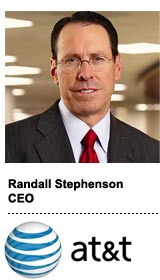
AT&T is juggling a lot of business units at the crossroads of media, advertising and communications.
Here are three takeaways from the company’s Q4 2018 earnings call on Wednesday that you can bring to the water cooler.
DirecTV Now lost subscribers … but it’s all in the plan?
When AT&T scaled back on promotions of its DirecTV Now streaming TV subscription service, it lost 267,000 subscribers.
But company CEO Randall Stephenson insisted that’s a good thing.
His rationale is that the departing customers have low lifetime value and aren’t particularly engaged. Since introducing DirecTV Now in November 2016, AT&T has learned a lot about how people use it, he said.
“There was one [customer segment at] the low end that was not engaging with the product,” he said. “We didn’t have Xandr set up to monetize meaningfully in the digital side.”
AT&T pulled the promotional pricing and let those customers go, though some, Stephenson said, migrated to the higher DirecTV Now price tier.
“Now we have a customer base on the streaming that’s growing, and that’s highly engaged, with good churn characteristics,” he said. “So we actually like where we are.” He noted average revenue per user of the DirecTV Now product grew $10 over the quarter.
That’s the cheery perspective, but it does underscore the challenge of attracting and retaining streaming TV customers who have ever more options when it comes to high-quality video entertainment. On top of that, building and maintaining a streaming service is expensive – and those costs seem to be hitting everyone at once.
Walmart curtailed its video portal ambitions earlier this month. Disney also paid a price supporting its Hulu and BAMTech platforms.
And, as Stephenson pointed out during the earnings call: “Customers aren’t willing to pay as content costs grow.”
Xandr’s great expectations
Despite the recent rumblings from AT&T’s ad unit Xandr – availing some data and segments for Turner, for instance – AT&T doesn’t expect Xandr to really be at full strength until 2020.
2019 is “a year of development,” Stephenson said. The big opportunity, when AT&T can prove the results of Xandr customer insights informing ad inventory, will come in 2020.
The more success Xandr has, Stephenson said, the more other content owners will bring their inventory to the Xandr marketplace.
And Stephenson’s expectations for Xandr are tremendous.
“Do I expect Xandr to outperform the market?” Stephenson said. “Absolutely. I would be sorely disappointed if we don’t outperform the market.”
Xandr’s total Q4 revenue was $566 million, up 49% YoY, or 26% excluding AppNexus. Much of that growth was driven by political advertising – but Stephenson said Xandr grew even without that anomaly.
Competition? Not a problem.
Just as Netflix isn’t worried about all the competitive streaming services coming to market, AT&T isn’t either. “We have really high expectations for our streaming service,” Stephenson said. “We don’t think there will be a proliferation of these over time, just those with deep libraries of IP.”
Stephenson underscored AT&T’s commitment to a two-sided business model. There will be one that relies on subscriptions and no ads – that would be HBO content and premium, theatrical content from the Warner Bros. studio – and a model that relies on ads. Of course, that’s where Xandr comes into play.
And AT&T will still license some of its WarnerMedia content – the sitcom “Friends” being the $100 million example. Remember that Netflix opened up the coffers for an non-exclusive license to host the show through 2020.
“In terms of the decision making of what to do with premium content, there won’t be a cookie cutter approach,” Stephenson said. “I don’t think all content is equal. ‘Friends’ was a situation where you ask how important is it to have that content on an exclusive basis. That’s where we said exclusivity is not important for that content, but it’s important to have it on our platform.”
This post was syndicated from Ad Exchanger.


More Stories
TRA’s survey reveals New Zealand’s favourite ad campaigns
McDonald’s Christmas Light Show is an Ode to Spontaneous Drive-Thru Dinners
Behind the Scenes of Coca-Cola’s AI Reinvention of a Holiday Classic